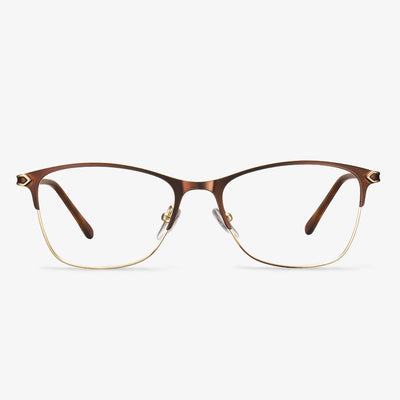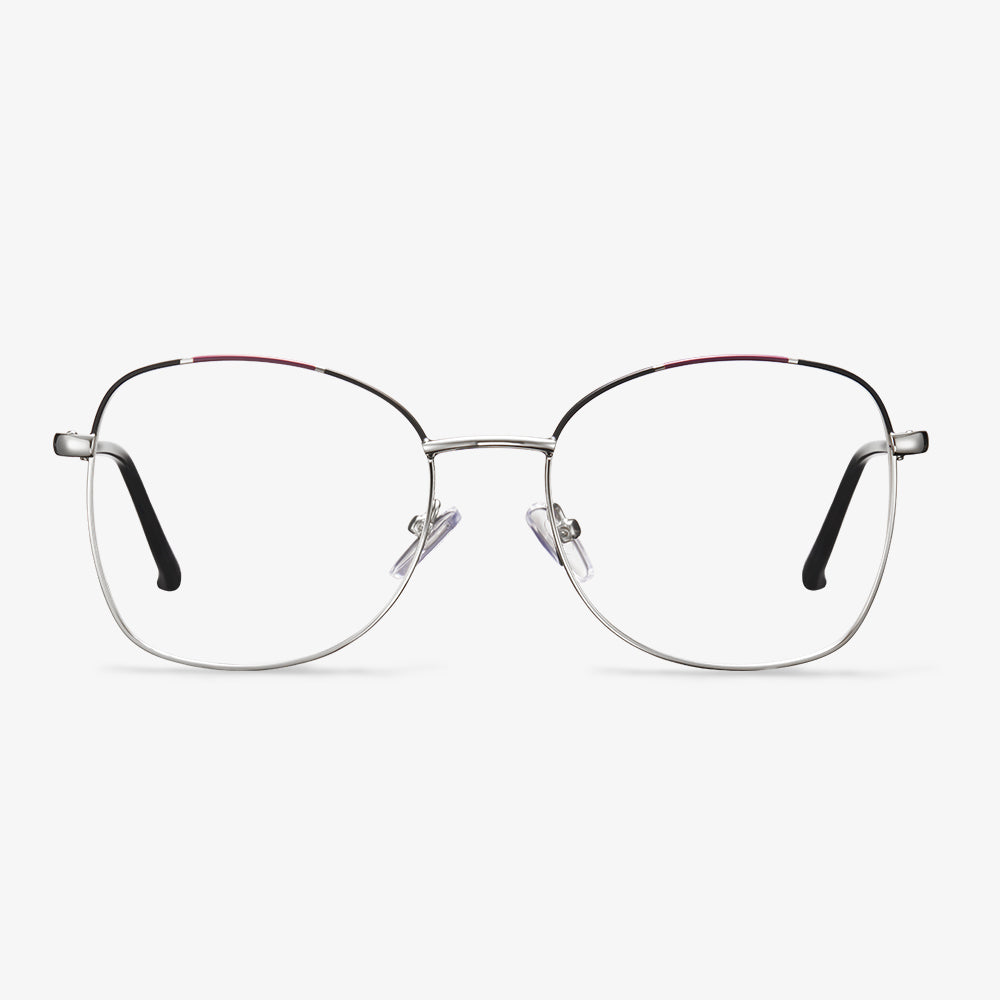Square-frame glasses
This frame is usually reserved for working women and can be paired with a simple or slightly sexy look, with tall eyebrows and dark lipstick. If they are big-frame glasses, usually they are more popular with some star friends. Big frame glasses collocate energetic dress-up, making a person unexpectedly full of sunshine and affinity.
Single Vision vs Progressive: What Are Their Differences
With single vision lenses, you can also just use the center of the lenses to avoid prismatic effects if your prescriptions are very unequal for both eyes.
As for progressive vs single vision, they also have differences in frame selection. You will stick to frames when choosing progressive lenses that will provide you with a minimum height of 14mm from the point you are looking through the lenses into the distance to the point you are looking down while you read.
Besides the above differences, they are also some other differences between single vision glasses and progressive lenses. You can choose either one based on your needs. To choose glasses, Koalaeye glasses are recommended. They come in stylish and at a cheap price.
What are NXT Lenses?
NXT lenses are made of Trivex materials. Trivex (Chinese name: Ethyl Carbamate Polymer) was invented by PPG in 2001.
Impact resistance:
Impact resistance is the main feature of the NXT lens. As a visual armor material originally used in the military field, Trivex has effective impact protection to the eye when it is most demanded. It is 10 times stronger than PC lenses in impact resistance and will last for life under normal use. It is the only explosion-proof safety lens on the market that can withstand external forces and turns.
Patented color injection technology :
Color representation is another important feature of NXT lenses. The biggest defect of the regular lens in dyeing is color aberration. The same color of the lens with different luminosity will produce different effects. The higher the refractive index, the serious the error. NXT lenses are a breakthrough in this respect. The patented color injection technology that infuses the color into the raw material gives the lens a natural color, ensuring that color aberrations are minimized and that they do not fade or change color over time or over long periods of use like other materials.
Abbe number and internal stress:
The Abbe number of NXT lenses made of Trivex is 43~45, which is close to CR39(58) and higher than PC lenses (29~32) and high folding lenses (32~41). At the same time, because the NXT lens is produced by the casting process, there is no stress in the finished lens, which further reduces the rainbow phenomenon, providing a guarantee for the clear visual effect and reducing eye fatigue.
Weight:
The specific gravity of NXT lens is 1.11g/cm3, 16% lighter than CR39 (1.32g/cm3) and 10% lighter than PC tablet (1.22g/cm3). The Trivex 1.53NXT medium-fold lens is so light that it can float.
Westie Dog Eyeglass Holder
The spirit of Westie is captured by this adorable dog frame, which stands about 4.5 inches tall and can be fitted with glasses, sunglasses, and so on. This dog frame is a great choice for children's frames. It uses high-quality resin designed and manufactured in the UK. Each dog spectacle frame is hand-painted and comes in a gift box.
Heart-shaped face with angular glasses
The heart-shaped face is also a common face shape in daily life. This face shape is somewhat similar to the inverted triangle face shape. Generally, the chin is a relatively sharp face shape. For this type of face, the most important thing is to modify the cheekbones above the nose to highlight the slenderness of the chin. Therefore, it is better to wear a pair of angular glasses, which can effectively modify the facial lines and look more perfect.
The design evolution of progressive lenses
Spherical and aspheric designs
The design of the front surface of the far-use area of the early progressive lens is similar to that of the ordinary spherical single vision lenses, so it is called a spherical progressive lens. Since 1974, the front surface of the far-use region of the lens is designed to be aspheric by designers, which not only reduces the peripheral aberration but makes the lens thinner, lighter, and less powerful.
Hard and soft design
For hard design, the channel is short, and the gradient is large. The near-use area position is high. The effective visual area of remote and near-use areas was larger. Peripheral astigmatism is relatively concentrated. Because surrounding astigmatism increases rapidly and the distribution is dense, the curve effect is more obvious. The gradient area is narrow. It is more difficult and takes longer for wearers to adapt.
Lenses with soft designs have slower gradients, longer gradients, and wider gradients. The angle of rotation of the eye from the far area to the near area is greater. It's easier to get used to. Compared with the hard design, the effective visual area of the far and near use areas is smaller, and the location of the near use area is lower.
Single, diverse, and individualized design
Initially, the progressive lenses used a single design, in which each basic curve was scaled equally and a luminosity combination was added within the range of its semi-finished lens blanks. The steepest base curve uses the same lens design as the flattest base curve. Lenses designers quickly realized that the overall performance of the lens could be improved by microcustomizing the lens design, leading to progressive lenses with multiple designs. This kind of design is called diverse design. By the mid-1990s, there was the emergence of individualized lens designs. In addition to using different gradients, these first individualized lens designs used steeper baseline curves with a slightly larger approach area to compensate for increased magnification and reduced field of view.
Symmetrical and asymmetric design
There is no difference between the left and right eyes in the symmetrical design of progressive lenses. As the eyes turn inward when they see near objects, the gradual gradient area gradually tilts to the nasal side from top to bottom, so the left/right progressive lenses should be rotated clockwise/counterclockwise respectively during processing. An asymptotic lens with left and right eye divisions is called an asymmetric design. The gradient is gradually and moderately inclined to the nasal side from top to bottom. The refractive force, astigmatism, and vertical prism of the two sides of the left and right gradient of the asymmetric design lenses are basically similar. At the same time, considering the characteristics of eye movement parameters in binocular vision, the peripheral aberrations of the corresponding positions of the left and right lenses were appropriately balanced to improve the visual effect of the wearer.
Method of taking off the contact lens
Wash your hands before removing contact lenses, and be careful not to leave long fingernails, to avoid contamination of the lenses by bacteria and nail scratches. Look up, open the upper and lower eyelids with the left index finger and right middle finger. Pinch the middle and lower edge of the lens gently with the thumb and index finger of the right hand, and remove the lens. You can use the index finger first to move the lens down, and then gently pinch the middle and lower edge of the lens with the thumb and index finger belly, and take off the lens.











































